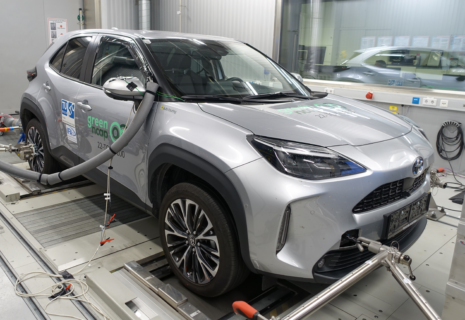Toyota Yaris Cross 1.5 hybrid FWD CVT
2022
52%
6.7
10
Clean Air Index
5.2
10
Energy Efficiency Index
3.7
10
Greenhouse Gas Index
| Laboratory Tests | NMHC | NOX | NH3 | CO | PN | |
|---|---|---|---|---|---|---|
| 7.210 | Cold Test | |||||
| 8.010 | Warm Test | |||||
| 6.510 | Highway | |||||
| 4.210 | Cold Ambient Test | |||||
| Road Test | ||||||
| 7.410 | On-Road Drive | |||||
| 3.05 | On-Road Short Trip | |||||
| 5.38 | On-Road Heavy Load | |||||
| 3.85 | On-Road Light Load | |||||
| 2.02 | Congestion | |||||
| Laboratory Tests | Energy | |||
|---|---|---|---|---|
| 6.810 | Cold Test | |||
| 6.910 | Warm Test | |||
| 2.610 | Highway | |||
| 4.610 | Cold Ambient Test | |||
| Consumption | Driving Range | |||
| Average | 6.0l100 km | 636km | ||
| Worst-Case | 8.3l100 km | 431km | ||
| Greenhouse Gases | CO2 | N2O | CH4 | |
|---|---|---|---|---|
| 5.910 | Cold Test | |||
| 6.010 | Warm Test | |||
| 0.310 | Highway | |||
| 3.010 | Cold Ambient Test |
Specifications
- Tested Car JTDKBABB50A00XXXX
- Publication Date 11 2022
- Vehicle Class Small MPV
- Emissions Class Euro 6d AP
- Tyres 215/50R18
- Mass 1,241 kg
- Engine Size 1,490 cc
- Power/Torque 85 kW/120 Nm
- Declared CO2 112 g/km
- Declared Consumption 5 l/100 km



































































































































Our verdict
Green NCAP tested the 2022 model of the Toyota Yaris Cross Hybrid with a 1.5 liter naturally aspirated gasoline engine, electric traction motor and a continuously variable transmission. This is a compact SUV targeting the buyers who look for high everyday comfort and functionality. The powertrain represents a good choice and demonstrating reasonable fuel consumption values together with effective minimisation of pollutants. The performance of the state-of-the-art exhaust aftertreatment system remained robust and effective under all test conditions but additional improvements are possible, especially with focus on trips with cold engine starts and dynamic conditions, where the Yaris would benefit from enhanced particle reduction measures. The quantities of emitted greenhouse gases are not unusual for a vehicle of such configuration and cap the overall result, positioning the Toyota Yaris Cross Hybrid in the fair range of 3 Green stars with a weighted Overall Index of 5.2.